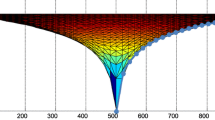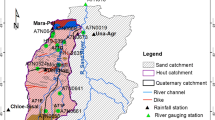Abstract
A distributed hydro-environmental model is developed that achieves detailed analysis of the movement of water at a field-plot-scale resolution in a mesoscale watershed including lowland areas where, especially for agricultures, it is an essential need to get rid of redundant groundwater by drainage facilities such as rivers, canals and/or underdrains. For this, the problem geometry is meshed with unstructured cells of triangular shape. Profile of a column cell is zoned into two: surface zone and groundwater zone in which water movement is represented by combined tank and soil moisture sub-models, and well-defined two-dimensional unconfined shallow groundwater flow sub-model, respectively. The top-two sub-models serve to evaluate evapotranspiration, infiltration, soil water content, lateral surface water flow, and vertical percolation. The vertical percolation so evaluated is given as longitudinal recharge to the bottom sub-model for computing groundwater flow. Surface water–groundwater interactions through beds and stream-banks of perennial and ephemeral canals are considered by treating the canal courses as internal boundaries in the groundwater flow model. The finite volume method (FVM) that allows of unstructured mesh and produces conservative solutions is employed for groundwater flow computation. The model developed is applied to an actual watershed which includes a low-lying paddy area to quantify the hydrological impact of land-use management practices over a period of 29 years in which the farmland consolidation project was implemented and part of the paddy fields were converted to upland crop fields and housing lands. From the results obtained, it is concluded that the model presently developed lends itself to water—as well as land-use management practices.












Similar content being viewed by others
References
Alam AHMB, Takeuchi J, Kawachi T (2006) Development of distributed rainfall-runoff model incorporating soil moisture model. Trans JSIDRE 244:29–37
Arnold JG, Srinivasan R, Muttiah RS, Williams JR (1998) Large area hydrologic modeling and assessment part I: model development. J Am Water Resour Assoc 34:73–89
Bormann H, Breuer L, Graff T, Huisman JA (2007) Analyzing the effects of soil properties changes associated with land use changes on the simulated water balance: a comparison of three hydrological catchment models for scenario analysis. Ecol Model 209:29–40
Brath A, Montanari A, Toth E (2004) Analysis of the effects of different scenarios of historical data availability on the calibration of a spatially-distributed hydrological model. J Hydrol 291:232–253
Cavendish JC, Field DA, Frey WH (1985) An approach to automatic three-dimensional finite element mesh generation. Int J Numer Methods Eng 21:329–347
Chiang WH, Kinzelbach W (2001) 3D-groundwater modeling with PMWIN—a simulation system for modeling groundwater flow and pollution. Springer, Berlin
Domenico PA, Mifflin MD (1965) Water from low permeability sediments and land subsidence. Water Resour Res 1(4):563–576
Editorial Board of Imazu History (2003) History of Imazu, vol 3, Local Government, Imazu Town, 467 pp (in Japanese)
Famiglietti JS, Wood EF (1994) Multiscale modeling of spatially variable water and energy balance processes. Water Resour Res 30:3061–3078
Flenckenstein JH, Niswonger RG, Fogg GE (2006) River-aquifer interactions, geologic heterogeneity, and low-flow management. Ground Water 44(6):837–852
Helmig R (1997) Multiphase flow and transport processes in the subsurface. Springer, Berlin
Hundecha Y, Bardossy A (2004) Modeling of the effect of land use changes on the runoff generation of a river basin through parameter regionalization of a watershed model. J Hydrol 292:281–295
Japan Society of Hydrology and Water Resources (1997) Handbook of hydrology and water resources, Asakura, Tokyo, 636 pp (in Japanese)
Krause S, Bronstert A, Zehe E (2007) Groundwater-surface water interactions in a North German lowland floodplain—implications for the river discharge dynamics and riparian water balance. J Hydrol 347:404–417
Lake Biwa Research Institute (1988) Moving atlas—Shiga prefecture regional environment atlas with data floppy disk, 83 pp (in Japanese)
Linsley RK, Kohler MA, Pauthus JLH (1958) Hydrology for Engineers. McGraw-Hill, New York, 340 pp
Mitsuno T, Nagahori K (1987) The structure of groundwater budget around Yoshii Weir—statistical analysis of ob-served groundwater level fluctuations around Yoshii Weir. Trans JSIDRE 127:27–33 (in Japanese)
Nakae S, Yoshioka T (1998) Geology of the Kumagawa district. Geological survey of Japan, Tsukuba, 71 pp (in Japanese)
Nakae S, Yoshioka T, Naito K (2001) Geology of the Chikubu Shima district. Geological survey of Japan, Tsukuba, 71 pp (in Japanese)
Nakagiri T, Watanabe T, Horino H, Maruyama T (1998) Development of a hydrological system model in the Kino River Basin—analysis of irrigation water use by a hydrological system model (I)-. Trans JSIDRE 198:1–11
Niehoff D, Fritsch U, Bronstert A (2002) Land-use impacts on storm-runoff generation: scenarios of land-use change and simulation of hydrological response in a meso-scale catchment in SW-Germany. J Hydrol 267:80–93
O’Connell PE, Nash JE, Farrell JP (1970) River flow forecasting through conceptual models. Part 2—the Brosna catchment at Ferbane. J Hydrol 10:317–329
Sugawara M, Ozaki E, Watanabe I (1986) River forecasting of the upper Irrawaddy River at Sagaing, Burma, using the tank model. Rep Natl Res Center Disaster Prev 36:47–57
Tan BQ, O’Connor KM (1996) Application of an empirical infiltration equation in the SMAR conceptual model. J Hydrol 185:275–295
Watson DF (1981) Computing the n-dimensional Delaunay tessellation with application to Voronoi polytopes. Comput J 24(2):167–172
Author information
Authors and Affiliations
Corresponding author
Rights and permissions
About this article
Cite this article
Takeuchi, J., Imagawa, C., Kawachi, T. et al. A refined hydro-environmental watershed model with field-plot-scale resolution. Paddy Water Environ 8, 175–187 (2010). https://doi.org/10.1007/s10333-010-0196-4
Received:
Revised:
Accepted:
Published:
Issue Date:
DOI: https://doi.org/10.1007/s10333-010-0196-4




